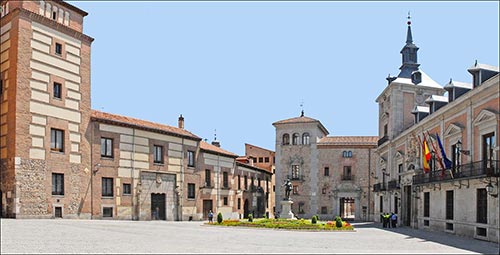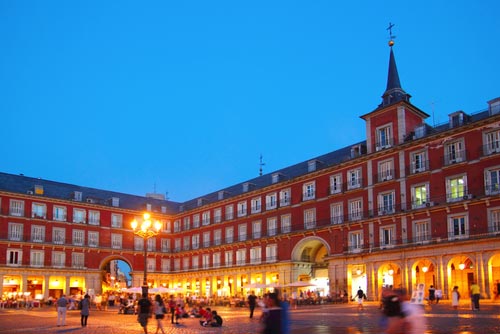The House of Austria is the name of the Spanish branch of the Habsburg dynasty reigning in the Spanish Monarchy in the sixteenth and seventeenth centuries. The name “Madrid de los Austrias” corresponds to the oldest part of Madrid, now designated in Sol and Palacio districts.
Madrid was a medium, but active, city with medieval aspect, until 1561 when Felipe II designated it as the capital of the Spanish monarchy. Thus, the Madrid de los Austrias refers to the urban expansion that took place between 1516 and 1700 under the reign of the House of Austria.
There are about one hundred monuments within the district of Austrias this little guide will highlight the top five. If you are interested to visit all the wonders of this city area, book our Madrid of the Austrias Walking Tour. Worth mentioning that the Hall of Kingdoms and the Cason del Buen Retiro -now part of the Museo del Prado– also belong to the works promoted by the Austrias family, but are excluded from the conventional route for being too remote.

Plaza de la Villa
The Madrid de los Austrias begins on the area of Calle Mayor to the Plaza de la Villa. This space was one of the most popular in the medieval Madrid; its current state is due to reforms driven before and after the reign of the Habsburgs. The Plaza de la Villa complex include: the Casa de la Villa (c. XVII), the House of Lujanes (c. XV), the Lujan House (1494), the Cisneros House (1537).

Plaza Mayor
The Plaza Mayor was originally a market square of the medieval city, its current appearance dates from 1580. This square is considered the ultimate expression of Habsburg style. Its designer was Juan de Herrera originally but it was finished by the royal architect Juan de Villanueva in 1790. The main building in Plaza Mayor is called “Casa de la Panadería”, it translation would be approximately “Bakery House” and the statue, placed in the center, represents Felipe III riding a horse. Nowadays, this square is one of Madrid’s main attractions for its lively atmosphere and great tapas bars.
The tour of Old Madrid continues through the streets San Justo and Sacramento, still in the streets of the Province and Santa Cruz. Then take the Toledo Street, where you should visit the Portal Cofreros, the Collegiate Church of San Isidro and the Colegio Imperial de Madrid. Then, it goes by the Plaza de la Paja, where you have to stop and admire the Bishop’s Chapel (1520-1535) and the Garden of the Prince of Anglona (c. XVII), , then takes Calle Segovia to the famous Puerta del Sol.

Puerta del Sol
The Puerta del Sol is located in the geographic center of Spain. The current appearance of the square dates from 1862, when part of the old city was demolished to create the square. Puerta del Sol complex includes: the Real Casa de Correos (1768), Casas de los Corderos (1845) and the famous sculpture named “El oso y el madroño” that has become the symbol of the city of Madrid. The Puerta del Sol is the center of life in Madrid, is the favorite place for protests, for cultural events and is also where all the locals receive the New Year.
The route continues along Calle Arenal, until the Plaza de Isabel II, home to the famous Teatro Real. Then passes through the Plaza de San Martin and the Plaza de las Descalzas, where you should visit the Monastery de las Descalzas Reales, built at the initiative of Joan of Austria in 1559.

Royal Palace
The last stop on the route through the neighborhood of Austria is the Royal Palace, built on the ruins of the Real Alcazar, residence of all the monarchs of the House of Habsburg until 1734. The Royal Palace, also known as Palacio de Oriente, was built in Baroque style from design architects Filippo Juvarra and Giovanni Battista Sacchetti. During construction the monarchs occupied the Palacio del Buen Retiro.
The Royal Palace has undergone major changes since its original design, so you cannot say that the building belongs only to the reign of the Habsburgs. Nowadays, the Royal Palace can be visited. Most of the rooms are decorated with precious objects and art pieces. The palace gardens (Jardines de Sabatini and Campo del Moro) are often included as part of the Madrid of the Austrias Tour, since they were planned in the 1561’s urban reform. Unfortunately, they were constructed in the XIX century under a different style and design.
Address
Calle Bailén, s/n. 28071, Madrid.
Opening Hours
October to March opens daily from 10:00 a.m. to 6:00 p.m. April to September opens daily from 10:00 a.m. to 8:00 p.m.
Getting Here
The closest metro station is Opera (Lines 5 and 2) and train station is Principe Pío. Also bus lines 3, 25, 39 and 148 have stops close to the palace.